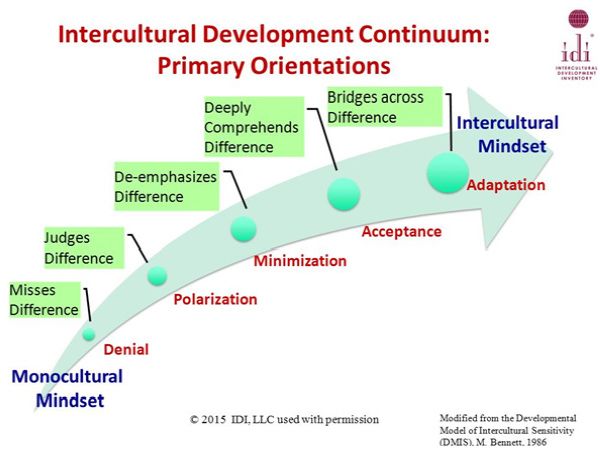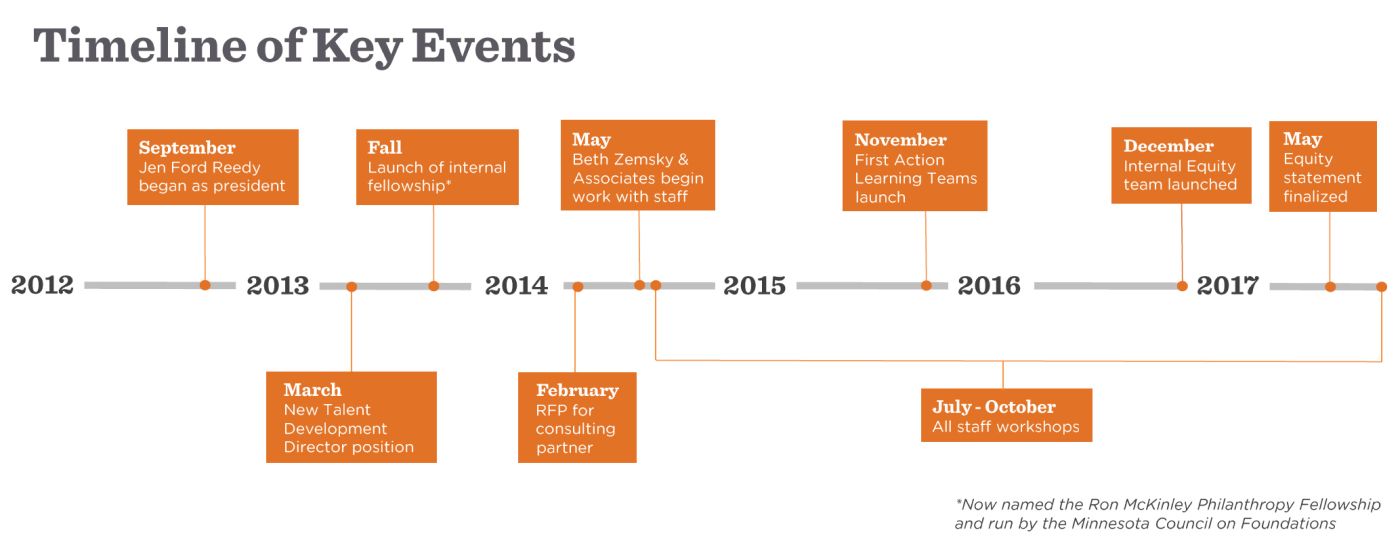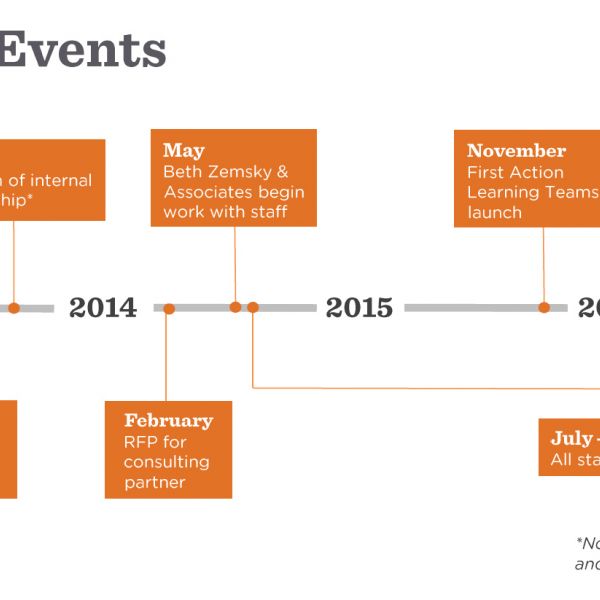Spreading and embedding an equity lens at the Bush Foundation
Published: April 2018
Contributors: Stephanie Andrews
Changing organizational culture takes intention and time. At the Bush Foundation, we’ve spent the last five years creating a more inclusive culture internally so that we can be more effective externally. From the people, to the programs, to the policies and processes — we’re working to build an organizational culture that is inclusive in action, diverse in makeup and driving towards equity.
In this paper, we want to highlight the questions and decisions we’ve made and what we’ve learned. Not because we’ve done it all right, or because we’re done. Other organizations have plowed this ground deeper and further than the Bush Foundation, and we’ve looked to them and learned from them. But with the benefit of some hindsight, here’s what we’ve learned, five years in.
The Foundation works to inspire and support creative problem solving, within and across sectors, to make our region — Minnesota, North Dakota, South Dakota and the 23 Native nations that share the geography — better for everyone. Although there was a long history of investment in historically black colleges and universities and tribal colleges, as well as active partnerships with the Native nations in the region, equity had not been an explicit focus of internal work or external strategy.
When Jen Ford Reedy joined as president in 2012, we took a decisive turn towards diversity, equity and inclusion. At that time, the Foundation’s 40-person staff was predominantly white, with experience ranging from very new to very adept in equity work. We had a strong learning culture that offered fertile ground for growth.
Jen made several changes immediately, including:
- Programmatic changes such as launching new open grant programs with significant applicant support to ensure equitable access, ensuring that at least 50% of those grants addressed economic and/or racial disparities, and making our flagship fellowship program more flexible in response to concerns from leaders of color.
- Creating an internal fellowship program to bring high potential people of color into grantmaking roles at the Foundation. This served a dual purpose of lending new perspectives to the program teams and providing an opportunity for underrepresented people to gain visibility and tangible resume-building grantmaking experience in a largely white sector.
- Overhauling hiring and recruiting practices so that our staff would better reflect the communities in which we work. In five years, the percentage of staff who identify as people of color grew from 14 percent to over 40 percent. A director-level talent position was created to provide more capacity and focus for the professional development and organizational culture work. Learn more from our (Internal) Talent Management for (External) Impact learning paper.
This fellowship program is now run by the Minnesota Council on Foundations, and has been renamed the Ron McKinley Philanthropy Fellowship, honoring Ron McKinley, a passionate advocate for bringing underrepresented people into philanthropy. The fellowship is serving as a sector-wide incubator for diverse talent in philanthropy with seven foundations and nineteen Fellows participating to date — eleven of them at the Bush Foundation.
The Steps We Took
Since then, we’ve made many more programmatic and operational changes to build a more inclusive culture. Here are some of the most important:
- We defined our operating values.
Early on, we dug deep into defining and shaping operating values. We talked about them a lot — at staff meetings, at board meetings, role playing “values challenges” to see what we’d do when our values came into conflict. These conversations, and the values themselves — like "Everybody Matters" — set the stage for more focused equity work. - We engaged a long-term consulting partner.
We issued a request for proposals (PDF) to find a partner that would help design and implement a “comprehensive training and development program to strengthen our skills in, and practice of, diversity, equity and intercultural competency.” We knew that this engagement needed to be multi-year and include deep learning at both the individual and organizational levels. We selected Beth Zemsky & Associates, because of their experience with other philanthropic organizations and because they were explicit about the capacity-building focus of their work. Their role wasn’t just to convey content, but to work themselves out of a job. - We learned together.
With our consultant, we came together for ten half-day required workshops (PDF) over the course of the first 18 months (and two refreshers later). To begin, all staff took the Intercultural Development Inventory (IDI) assessment. The IDI provided a baseline at both the individual and organizational level and gave us a shared language. Find more on the IDI in the “Key Decisions” section. We worked through concepts such as conflict and communication styles, power and adaptation, intent and impact, mattering and marginality, role plays, small and large group discussions, and interactive activities. - We put theory into practice.
With some shared learning in place, we launched our first Action Learning Teams. These cross-foundation, multi-level teams have worked together to revise policies, process and strategy to make them more inclusive and equitable. Our consultant was a key resource to these teams, providing guidance and coaching along the way. The teams have worked on topics like:- Making our bereavement leave policy (PDF) more flexible on eligibility — staff are eligible for bereavement leave when they lose someone who is “family or like family” — with more clarity around the activities the leave is intended to cover.
- Decreasing the number of defined holidays and increasing the number of floating holidays (PDF), coupled with more education and awareness.
- Looking at how our grantee selection processes can be more inclusive.
- We wrote an equity statement (…but not right away).
We didn’t develop a public statement on diversity until we’d been at this for a few years. The statement that we ultimately developed went beyond the ‘what’ and ‘why’ of our equity aspirations and turned into an ‘Equity Framework’ that offered direction on ‘how’ we’d do it. Our president, Jen led this team and worked closely with our Board along the way to stay aligned and get their input. - We created an Equity Team (PDF).
This team has several formal responsibilities, such as an organizational assessment of progress and selecting Action Learning topics. Team members also serve as our internal equity champions and create opportunities — and the safe space — for staff to have critical conversations about current topics, such as police violence and sexual harassment.- The Equity Team also sponsored lighter activities like “FoodConnect” where staff bring food that is important to them in some way and share their stories. In December, we talked about how much cultural and religious practices vary, even when people practice the same faith and how the dominance of Christmas creates a sense of belonging for some and exclusion for others. It was meaningful. It was inclusive. And it was just lunch.
- We incorporated an equity change into each staff person’s work plan.
Along the way, each staff person has been pursuing individual development plans to improve their intercultural skills. In 2018 we pushed beyond learning to requiring action from everyone. Every person has identified something that they will change to make our processes and practice more inclusive. This is a major step to ensuring that equity is deeply integrated into everybody’s work and our organization’s culture and way of operating.
Key Decisions
There were several important decisions along the way — some recognized as such in real time and summarized below. Others, critical in hindsight, have become some of the lessons we’ve learned. You’ll see those in the closing sections.
One of the first decisions was whether to focus exclusively on addressing racial equity or broader goals of intercultural skill building. We chose to focus on equity, broadly defined. Our region spans a large geographic area with urban, racially diverse cities and rural, racially homogenous areas and everything in between. Differences in lived experience and in politics are significant. In our everyday work, Bush Foundation staff work with people from a wide variety of backgrounds and need to be able to recognize and adapt effectively to all kinds of difference.
We engaged an outside partner and dedicated significant internal resources to this work. Many organizations won’t want or be able to dedicate as much time or money to shepherding this work forward. For us, having Beth Zemsky as an expert and consistent partner, and dedicated internal resources — about a quarter of my time as Talent Development Director — helped to spread and embed what we’d learned more quickly.
We brought the board along. Our board is hard working, engaged and diverse, reflecting a range of experiences and perspectives. With a quarterly meeting schedule, we knew that engaging them as deeply as staff wasn’t feasible. Instead, we created opportunities for them to share their own stories and experiences. As an example, at a Board meeting, our consultant led them through the “I am from…” exercise, (inspired by the George Ella Lyon poem, "Where I'm From") that invites people to share the details of their lives that add up to the person they are now. Board members are regularly asked to reflect on their own experience about a place we are going to visit or a topic to be discussed. Jen, the Foundation’s president, also regularly updated them on the progress of staff work on DEI and engaged them on the draft Equity Framework.

We used the Intercultural Development Inventory (IDI), to get a baseline and assess and illustrate progress. The IDI is a psychometrically valid assessment tool that identifies one’s developmental stage as it relates to intercultural understanding. People take the assessment and receive both a written profile and one-on-one interpretation with a licensed IDI administrator.
The IDI is developmental in approach — in other words, is grounded in the belief that intercultural competence is a learned skill. That perspective was hugely important. We could move away from thinking that somebody either got it or they didn’t. Most of us also received IDI results that showed that our skills didn’t quite match up with how interculturally competent we thought we were. But along with that cold water came some specific suggestions for developing our skills and the clear message that with intention and attention, we could get to where we aspired.
What’s Changed
As a Foundation, we have recently retaken the IDI assessment and our collective results reflect progress and movement toward acceptance — a stage characterized by “recognizing and appreciating patterns of cultural difference and commonality in our own and other cultures.”
This was an improvement from the first time we took the assessment, when the Foundation was in “minimization, on the cusp of acceptance” — a developmental stage summarized by the belief that “we’re all pretty much the same” without significant comfort in acknowledging or dealing with difference.
Our current activities reflect this progress. It’s getting harder to say what is equity work and what isn’t. We regularly ask different questions about who forms the work and who informs the work. Our calendars notify and teach us about a wide range of religious and cultural holidays. We offer more flexible investment options so that people can find tools and practices that align with their political and religious beliefs. We’ve added a private, all-gender restroom. All of our events have prayer space. We pre-record most webinars so that we can make sure closed-captioning is accurate. We consider more and different factors when selecting vendors (PDF). Far more funding is going to advance racial and economic equity.
What We’ve Learned
AS MUCH TIME AS YOU THINK IT WILL TAKE, IT TAKES MORE
It takes time to build trust and for new habits to take root. Taking the long view from the very start helped us weather the tough or ‘stuck’ times and reminded us that each bump along the way was a chance to learn and do better the next time. We also need to balance keeping the long view with maintaining a sense of urgency to make real progress. Some people on staff think we are moving too slowly and some believe the change is too fast. Bringing people along, to the edge of their comfort zone, and recalibrating when necessary, needs to be an ongoing focus.
IT CAN GET WORSE BEFORE IT GETS BETTER
We took the Center for Effective Philanthropy (CEP) staff survey in 2013 and 2015 and saw a decrease in satisfaction with the Foundation’s work on inclusion and equity. Surprise! In retrospect, this is absolutely predictable as the organization moved from minimizing cultural difference to noticing it and urgently wanting more. We may not have been less culturally competent, but we were more troubled about not being as culturally competent as we wished. That’s progress but it can feel like anything but.
STEADY EXECUTIVE LEADERSHIP IS CRITICAL
Because when it gets messy (or when your CEP data goes downhill!) people need to be reassured that the boss won’t cut and run, and that the Board is also in it with you.
YOU’LL NEED PATIENCE, HUMILITY AND A THICK SKIN
This work is deeply personal. Your organizational culture can’t become more inclusive without going deep into your beliefs and biases and those of everybody around you. For some people that feels like an inappropriate crossing of boundaries in the workplace. You must listen differently, to pay attention to what’s being said, and what isn’t being said. It’s almost certain that you will offend and be offended, and you will probably have to apologize more than you expect. Feeling uncertain and a bit awkward will become familiar. As you learn more, you realize you know less and that is either humbling or energizing, depending on the day.
YOUR ORGANIZATION ISN’T STATIC
In our first year, we had a powerful collective experience with frequent workshops and deep learning. But our talent strategy of actively encouraging professional development and mobility means that people regularly transition in and out and we’ve found it difficult to deliver that same depth of experience to newer hires. While new staff take the IDI in the first quarter of their arrival, we need to do a better job at telling the story of this journey as we onboard. This paper, and the related files below, are a start towards recounting this journey with more depth and texture.
...THE WORLD TURNS TOO
Tumultuous community events, such as the 2016 killing of Philando Castile just a few miles away from our offices in St. Paul, led to deep and sometimes painful insights about how differently people see and respond to the same events based on their life experiences. We’ve learned how each of us, and the organization, must be ready to shift gears and to respond to unplanned events in a way that aligns with our equity and culture goals.
What’s Ahead?
We have a few specific short to medium term goals:
LEANING INTO DISAGREEMENT
We are a deeply collaborative and congenial group of people and we live in the land of Minnesota Nice. Living our value of “More Good. Every Year.” means that we are regularly looking back and ahead, adjusting and refining strategy and execution. Although our default mode is to ask broadly and often for feedback and input, we move quickly and don’t always ask early enough or listen carefully enough to impact the product or process satisfactorily. We will keep working on embedding feedback loops and increasing space for and comfort with more perspectives. Disagreement and conflict still go underground too often.
SUSTAINING CHANGE
We will keep improving orientation and onboarding and building staffing models that work. Participation in the Equity Team, or the Action Learning teams, are big lifts for the people involved and we need to balance the desire for broad ownership of the equity work with sustainable workloads.
CELEBRATING PROGRESS
This is long term and hard work, and we aren’t yet where we want to be. Our culture is most comfortable talking about what we can do better. Recognizing the progress, we’ve made and lifting up the joy and fun from having such a diverse and interesting bunch of colleagues will help to keep the momentum and inspiration alive.
Conclusion
We hope that sharing our story — incomplete as it is — will leave you with ideas on how you might make your own organization more inclusive. Our decisions may not ring true in your context. Your journey will be different. For us, we know that our deep internal work brings our external equity goals closer in view.
Related Files
All Staff Workshops | 2014-2017 (PDF)
Bereavement Leave Policy | 2015 (PDF)
Equity Team Charter | 2017 (PDF)
Holiday Policy | 2015 (PDF)
Intercultural Competency Training & Development RFP | 2014 (PDF)
Vendor Form | 2018 (PDF)

